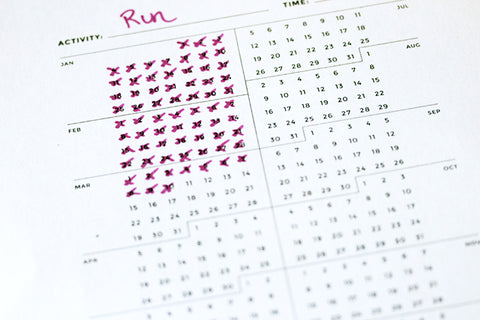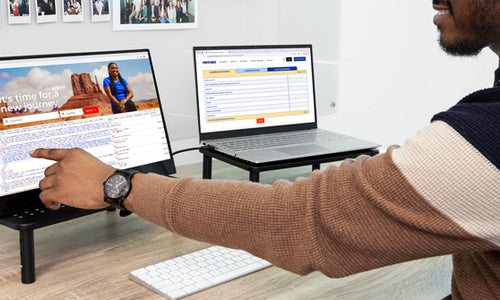Using the Seinfeld Method
In search of finding ways to be productive, the Seinfeld Method is a great productivity tool that can help you stop procrastinating. This productivity model works best for completing daily tasks and forming sustainable habits. You can use this at work or in your personal life!
We will go over what the Seinfeld Method is, how it’s used, its benefits, and drawbacks, so we can be one step closer to being more productive in our day-to-day.

What is the Seinfeld Method?
This technique is named for the world's top-earning comedian, Jerry Seinfeld. With a net worth of $950M (and counting), it's no wonder why junior comedians and writers look up to Seinfeld's work ethic. It's hard to exactly pin down when and where the technique started, but Brad Isaac, blogger, and champion of the Seinfeld Method, attributes origins to a comedy club in the early 90s.
As urban legend would have it, Seinfeld–a real heavyweight on the standup scene–was performing at a comedy club in the early years of his self-titled sitcom. Isaac, a young comedian at the time, was in the audience when he saw Jerry hanging out before his set. Isaac figured this would be his best shot to ask Seinfeld for advice and seized the opportunity.
"Any tips for a young comic?" Isaac asked.
Seinfeld had an answer primed and ready to go. While it's hard to believe the quote to follow was verbatim what was said, it's safe to assume it was some version of this:
“
In order to succeed at comedy, you need to tell better jokes. And in order to tell better jokes, you need to write every day. So what you need to do is get a giant calendar of the whole year, and every day that you write a new joke, mark a big red 'X' on that day. Then it's as simple as not breaking the chain.
Simple enough, right? Just don't break the chain. But how exactly can this be applied to more traditional work settings and how can you make the Seinfeld Method work for you?
How to use the Seinfeld strategy

The Seinfeld Method relies on a task that is both 1) Meaningful enough to create noticeable change and 2) Simple enough to complete in its entirety every day.
So while "finalize quarterly budget" is perhaps not a good task to apply this method to, "Dedicate 1 hour to budget report" could work. Additionally, the Seinfeld Method can help keep you on track with your side hustle or goals that don't necessarily pertain to work. People who have had success using this productivity technique generally apply it to practicing creative endeavors, exercising, or particular eating habits. That said, as long as the task you choose is well-defined and easily replicated, you can make the Seinfeld Method work for you.
Once you've decided on the task, you'll just need a calendar and a marker. I urge you to not go digital with this: Get yourself a real, honest-to-goodness paper calendar and a big red marker. I guess you can use any kind of marker you want (or really any writing utensil you want), but there's something very satisfying about marking Xs in red.
You can find free printable calendar images, or you can buy an inexpensive one pretty much any place paper goods are sold. Put the calendar someplace you'll see it: lay it on your desk, nail it to the wall by your door, tape it to the inside of your medicine cabinet.
Next, decide on the productivity model that works for you. Seinfeld says "Don't break the chain," but you can modify this if you need to. Of course, this model works best if you are truly completing the task at hand every day, but go easy on yourself. If your goal is to exercise, give yourself rest days. If your goal is based around the workweek, take the weekends off. Decide what's going to fare best for you and commit to it. From there, it's just a matter of accomplishing your goal, marking those Xs, and watching your chain grow. It'll get easier the longer the chain gets.
Benefits of the Seinfeld method
The genius of the Seinfeld Method is it almost gamifies your goal. A common practice in many marketing and productivity models, gamification means applying principles native to gameplay (point-earning, scorekeeping, etc.) to a more traditional task. Creating a chain at first just looks like one or two Xs on a calendar, but after a week or so, it really starts to take shape. You've trained your brain to anticipate goal completion and associates a finite pleasurable image with success. Remember playing "keep it up" with a soccer ball or a partially deflated balloon when you were a kid? It's similar to that: The longer to keep it up, the more you don't want to drop the ball.

Another benefit of the Seinfeld Method is it encourages a more micro-level view of a larger task. Asking Jerry Seinfeld the secret to his success is a pretty large question, but his response breaks it down into something simple: One joke a day. One joke at a time doesn't feel too overwhelming, but after a month, you have 30 new jokes. Even if they aren't all winners, that's enough to put together a pretty sizable standup act. That applies to whatever you're using the Seinfeld Method for: 1 hour of exercise a day is making you overall much stronger and healthier, etc.
Drawbacks of the Seinfeld method
Like the other productivity methods we've covered, the Seinfeld Method isn't perfect. The main issue with the Seinfeld Method is the amount of emphasis placed on all-or-nothing productivity. There's no "making some progress"; you either did it or you didn't. And in some ways, this is a good thing. As mentioned above, the Seinfeld Method is an excellent motivator and encourages long-term productivity, but what happens if you break the chain?
Even if no one's explicitly saying it, there's a certain shame associated with breaking the chain. Taking a day off is something to feel badly about, instead of some time to recuperate or simply enough some time to yourself. This becomes slippery if you're an "all or nothing" kind of person. If your pendulum swings from one extreme to the other, it may be difficult to keep up with the Seinfeld Method. Breaking the chain can become a hard stop to your productivity if you're not careful. The Seinfeld Method requires the caveat of being kind to yourself if you slip up.
Overall
One of the great things about the Seinfeld Method is the range of tasks it can be applied to. While other productivity models we've reviewed are really only suited to traditional office work, you can use the Seinfeld Method for many different types of tasks. In fact, you can even couple this technique with other productivity tools!



